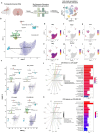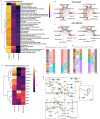Transcriptomic signature, bioactivity and safety of a non-hepatotoxic analgesic generating AM404 in the midbrain PAG region
- PMID: 38750093
- PMCID: PMC11096368
- DOI: 10.1038/s41598-024-61791-z
Transcriptomic signature, bioactivity and safety of a non-hepatotoxic analgesic generating AM404 in the midbrain PAG region
Abstract
Safe and effective pain management is a critical healthcare and societal need. The potential for acute liver injury from paracetamol (ApAP) overdose; nephrotoxicity and gastrointestinal damage from chronic non-steroidal anti-inflammatory drug (NSAID) use; and opioids' addiction are unresolved challenges. We developed SRP-001, a non-opioid and non-hepatotoxic small molecule that, unlike ApAP, does not produce the hepatotoxic metabolite N-acetyl-p-benzoquinone-imine (NAPQI) and preserves hepatic tight junction integrity at high doses. CD-1 mice exposed to SRP-001 showed no mortality, unlike a 70% mortality observed with increasing equimolar doses of ApAP within 72 h. SRP-001 and ApAP have comparable antinociceptive effects, including the complete Freund's adjuvant-induced inflammatory von Frey model. Both induce analgesia via N-arachidonoylphenolamine (AM404) formation in the midbrain periaqueductal grey (PAG) nociception region, with SRP-001 generating higher amounts of AM404 than ApAP. Single-cell transcriptomics of PAG uncovered that SRP-001 and ApAP also share modulation of pain-related gene expression and cell signaling pathways/networks, including endocannabinoid signaling, genes pertaining to mechanical nociception, and fatty acid amide hydrolase (FAAH). Both regulate the expression of key genes encoding FAAH, 2-arachidonoylglycerol (2-AG), cannabinoid receptor 1 (CNR1), CNR2, transient receptor potential vanilloid type 4 (TRPV4), and voltage-gated Ca2+ channel. Phase 1 trial (NCT05484414) (02/08/2022) demonstrates SRP-001's safety, tolerability, and favorable pharmacokinetics, including a half-life from 4.9 to 9.8 h. Given its non-hepatotoxicity and clinically validated analgesic mechanisms, SRP-001 offers a promising alternative to ApAP, NSAIDs, and opioids for safer pain treatment.
Keywords: CNS; Liver toxicity; Non-opioid; Phase 1 trial; scRNA-seq.
© 2024. The Author(s).
Conflict of interest statement
H.A.B., J.A.-B., and N.G.B. are named on a patent assigned to the Board of Supervisors of Louisiana State University and Agricultural and Mechanical College and University Alcalá de Henares describing the synthesis and characterization of the novel non-hepatotoxic acetaminophen analogs, patent application PCT/US2018/022029, international filing data 12.03.2018; publication date 28.02.2019; which has been nationalized in numerous jurisdictions. H.A.B. and N.G.B. are co-founders of South Rampart Pharma, which has a license and commercial interest in the above patent applications, including a financial interest in the commercial success of SRP-001. They stand to potentially receive financial payments if SRP-001 is commercially successful.
Figures





Update of
-
Transcriptomic signature, bioactivity and safety of a non-hepatoxic analgesic generating AM404 in the mid-brain PAG region.Res Sq [Preprint]. 2023 May 4:rs.3.rs-2883310. doi: 10.21203/rs.3.rs-2883310/v1. Res Sq. 2023. Update in: Sci Rep. 2024 May 15;14(1):11103. doi: 10.1038/s41598-024-61791-z. PMID: 37205420 Free PMC article. Updated. Preprint.
References
Publication types
MeSH terms
Grants and funding
LinkOut - more resources
Full Text Sources
Miscellaneous

